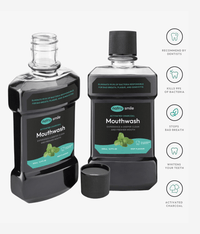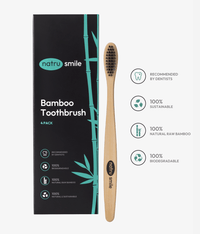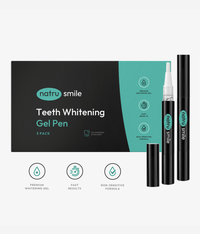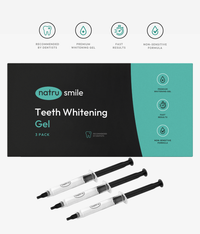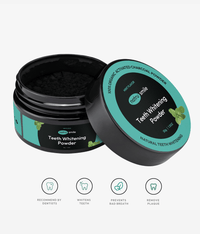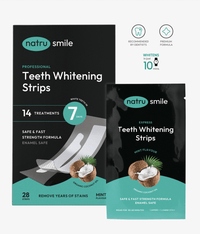
All products are certified by dental expert Dr. Greg Grillo
Are you considering getting veneers but have concerns about your receding gums? It's a valid concern because veneers require a stable and healthy foundation to properly adhere to your teeth. So whether or not dental veneers are a good choice can get confusing.
But, fear not, because we're here to help.
Veneers are a popular cosmetic dental treatment that can help improve the appearance of your teeth by covering up imperfections such as chips, cracks, and discoloration. They’re a great choice for people looking to improve their smile, but there are some things to consider when looking into them.
In this article, we will discuss everything you need to know about veneers and receding gums, and how to decide if veneers are right for you.
Why Do Gums Recede? TOP Causes
Gum recession is a common dental problem that affects many people.
It occurs when the gum tissue around the teeth pulls back or wears away, exposing the roots of the teeth. This can cause the teeth to look longer and can make them more sensitive. Gum recession can also lead to more serious dental problems, such as tooth decay and tooth loss.
There are several factors that can contribute to gum recession, we’ll look at the top causes below.
Dental Plaque Or Tartar Buildup.
Poor oral hygiene, such as not brushing or flossing properly, can lead to a buildup of plaque and bacteria that can cause gum disease. This can result in inflammation of the gums, which can cause them to recede.
Genetics
Genetics can also play a role in gum recession, as some people may be more prone to this condition than others. If gum recession runs in your family, you may be more likely to develop this problem.
Hormonal Changes
Hormonal changes can also cause gum recession, particularly in women.
fluctuations during puberty, pregnancy and menopause can cause changes in the gum tissue, making it more susceptible to recession.
Aggressive Brushing
Aggressive brushing can also cause gum recession. Brushing your teeth too hard or using a toothbrush with hard bristles can damage the delicate gum tissue, leading to recession.
Periodontal Disease
Gum disease, which is also called periodontal disease, is one of the leading causes of gum recession.
This condition occurs when there is an infection of the gum tissue, which can cause inflammation and damage to the gum tissue. As the infection progresses, the gum tissue can pull away from the teeth, leading to recession.
Trauma Or Injury To Your Gum Tissue
Trauma or injury to the gum tissue can cause it to recede. This can occur due to a variety of reasons, such as aggressive brushing, using a toothbrush with hard bristles, or a dental procedure that is not performed correctly.
Abnormal Tooth Positioning (Misalignment)
When teeth are not properly aligned, they can put pressure on the surrounding gum tissue, leading to recession. Misaligned teeth can also make it difficult to clean between the teeth, which can contribute to gum disease and recession.
Lip And Tongue Piercings
Oral piercings, such as lip and tongue piercings, can also contribute to gum recession. The jewelry can rub against the gum tissue, causing it to wear away over time.
Smoking Or Chewing Tobacco Use
Tobacco contains harmful chemicals that can damage the gum tissue and the surrounding structures of the teeth. These chemicals can weaken the connective tissue that holds the teeth in place, causing the gums to pull away from the teeth and leading to gum recession.
The reduced blood flow to the gums caused by smoking and chewing tobacco can also lead to gum recession. This is because the gums need a good blood supply to stay healthy and strong.
Without proper blood flow, the gum tissue can become weak and more prone to recession.
Who Does Gum Recession Affect?
While it’s true that gum recession can affect anyone, regardless of age or gender, some people may be more prone to gum recession than others.
One of the most common risk factors for gum recession is age.
As we age, the gum tissue naturally begins to wear away, which can lead to gum recession. Additionally, older adults may also be more susceptible to other risk factors for gum recession, such as periodontal disease and misaligned teeth.
Other risk factors for gum recession include poor oral hygiene, genetics, hormonal changes (such as those that occur during pregnancy), and certain medical conditions (such as diabetes).
While anyone can develop gum recession, certain groups may be more likely to experience it. For example, individuals who have a family history of gum disease or who have poor oral hygiene may be at a higher risk.
Types Of Gum Veneers
Gum veneers, also known as dental veneers, are thin shells made of porcelain or composite resin that are placed over the surface of the teeth to improve their appearance. They are also used to address issues with gum recession.
There are two main types of gum veneers: removable and fixed.
Removable Veneers
Removable veneers, also known as flexible gum veneers, are a non-invasive and affordable option for individuals who want to improve the appearance of their teeth and gums. These are designed to fit over the existing teeth and can be easily removed for cleaning and maintenance, so they are great temporary veneers.
One of the main benefits of removable veneers is that they are a reversible solution. If a patient is not happy with the results, they can simply remove the veneers without any damage to their teeth.
However, removable veneers may not be suitable for all individuals. They may not be as durable or natural-looking as fixed veneers and may require more frequent maintenance.
Fixed Veneers
Fixed veneers, also known as permanent gum veneers, are a more permanent solution for addressing gum recession and improving the appearance of the teeth.
These veneers are custom-made for each patient and are permanently bonded to the teeth using dental cement.
Fixed veneers are typically made of porcelain and are designed to be durable, long-lasting, and natural-looking. They can be used to address a variety of cosmetic issues, including gum recession, misaligned teeth, and discoloration.
While these permanent gum veneers are a more invasive procedure than removable veneers, they may be a better option for individuals who are looking for a long-lasting and natural-looking solution for their dental concerns.
Is It Possible To Get Veneers For Receding Gums?
If you are experiencing gum recession and are interested in improving the appearance of your teeth, you may be wondering, can you get veneers with receding gums?
The short answer is yes, it is possible to get veneers for receding gums. However, the success of the procedure will depend on the severity of your gum recession and the specific circumstances of your individual case.
In cases of mild to moderate gum recession, veneers can be used to cover the exposed tooth roots and improve the appearance of the teeth. However, if the gum recession is severe, additional treatment may be necessary before veneers can be applied.
Before the veneer application, it is important to address the underlying cause of the gum recession, such as periodontal disease or smoking. Treating these issues can help prevent further gum recession and ensure the success of the veneer application.
Additionally, your dentist may need to prepare the teeth by removing a small amount of enamel to create a surface for the veneer to adhere to. This process is irreversible, so it's important to carefully consider your decision before moving forward with veneer treatment.
Alternative Options For Treating Gum Recession
While veneers can be a viable option for addressing gum recession, there are other alternative treatments that may be more suitable for certain individuals.
These treatments include:
Gum Grafting
Gum grafting is a surgical procedure in which gum tissue is taken from another area of the mouth and transplanted to the area of recession. This procedure can help to cover exposed tooth roots and prevent further gum recession.
Scaling And Root Planing
Scaling and root planing is a non-surgical procedure that involves deep cleaning of the teeth and gums to remove plaque and tartar buildup. This procedure can help to prevent further gum recession and improve overall gum health.
Orthodontic Treatment
Misaligned teeth can contribute to gum recession by creating areas that are difficult to clean. Orthodontic treatment, such as braces or aligners, can help to reposition the teeth and prevent further gum recession.
Lifestyle Changes
In some cases, lifestyle changes may be necessary to address the underlying cause of gum recession. This may include quitting smoking, improving oral hygiene habits, and eating a healthy diet.
Topical Antibiotics
Topical antibiotics can be used to treat gum disease, which can be a contributing factor to gum recession. These antibiotics are applied directly to the gum tissue to kill bacteria and promote gum healing.
Dental Bonding
Dental bonding is a cosmetic dental procedure in which tooth-colored resin is applied to the teeth to improve their appearance. This procedure can be used to cover exposed tooth roots and improve the appearance of the teeth.
How Long Do Gum Veneers Last?
The lifespan of gum veneers can vary depending on factors such as the material used, the individual's oral hygiene habits, and the extent of gum recession.
On average, gum veneers can last anywhere from 5 to 15 years. However, with proper care and maintenance, they can last even longer. It's important to follow good oral hygiene practices, such as brushing twice a day, flossing daily, and visiting your dentist regularly, to help prolong the lifespan of your gum veneers.
Can You Eat With Gum Veneer?
Yes, you can eat with gum veneers, but it's important to take certain precautions to avoid damaging them.
It's best to avoid hard or crunchy foods, such as ice, hard candy, and nuts, as they can cause the veneers to crack or chip. As well, it's important to avoid biting into hard objects, such as pens or fingernails, as this can also damage the veneers.
To prevent unnecessary damage, it’s recommended to cut food into smaller pieces and chew with your back teeth to reduce the amount of pressure on the veneers.
Overall, practicing good oral hygiene habits and avoiding potentially damaging foods and habits can help to prolong the lifespan of your gum veneers.
Can You Get Veneers With Weak Gums?
It's not recommended to get veneers if you have weak gums or gum disease.
Veneers require a stable and healthy foundation to properly adhere to function. If your gums are weak or unhealthy, they may not be able to support the veneers properly, leading to potential complications and a shortened lifespan for the veneers.
It's important to address any gum issues before considering veneers, and your dentist can recommend alternative treatment options if necessary.
How Do You Choose The Right Veneer Color?
Choosing the right veneer color is an important part of the process to ensure that your new smile looks natural and matches the rest of your teeth. A skilled cosmetic dentist will work with you to find the perfect shade of veneer that complements your skin tone, facial features, and personal preferences.
To choose the right veneer color, your dentist will typically begin by evaluating the color of your natural teeth and taking into consideration any existing dental work, such as fillings or crowns. They may also take into account factors such as the shape of your face and the amount of visible gum tissue when you smile.
Your dentist will then use a shade guide to select the most appropriate color for your veneers. Shade guides typically contain a range of tooth colors, from very light to very dark, and may also have additional shades for the translucency and opacity of the veneers.
How Common Is Gum Recession?
Gum recession is a relatively common dental issue, affecting up to 50% of adults in some form.
It's more common in people over the age of 40, but it can occur at any age. Certain risk factors, such as smoking, poor oral hygiene, and genetics, can increase the likelihood of gum recession.
It's important to practice good oral hygiene habits and visit your dentist regularly to help prevent and address gum recession.
What Are The Symptoms Of Gum Recession?
The symptoms of gum recession can vary depending on the severity of the condition, but common signs and symptoms include:
- Tooth sensitivity or pain, especially when consuming hot or cold foods or drinks.
- Visible roots of the teeth or a longer appearance of the teeth
- Changes in the appearance of the gums, such as redness, swelling, or inflammation
- Bleeding gums when brushing or flossing
- Bad breath or a bad taste in the mouth
- Loose or shifting teeth in severe cases.
If you notice any of these symptoms, it's important to consult with your dentist as soon as possible to address the issue and prevent further damage.
How Can I Reduce Sensitivity Caused By Gum Recession?
If you are experiencing sensitivity caused by gum recession, there are a few things you can do to help alleviate the discomfort:
- Use a desensitizing toothpaste: These toothpastes contain compounds that block the pathways that lead to nerve endings in the teeth, reducing sensitivity.
- Use a soft-bristled toothbrush: Brush gently with a soft-bristled toothbrush to avoid further irritation to the exposed tooth roots.
- Practice good oral hygiene: Brush twice a day and floss daily to keep your teeth and gums healthy, and to reduce the risk of further recession.
- Avoid acidic or sugary foods and drinks: These can aggravate sensitive teeth and make the discomfort worse.
- See your dentist: Your dentist can recommend specific treatments, such as fluoride treatments, sealants, or bonding, to help alleviate sensitivity caused by gum recession.
Remember, it's important to address gum recession and tooth sensitivity as soon as possible to prevent further damage and maintain good oral health.
What’s The Best Toothpaste For Gum Recession?
There is no one-size-fits-all answer to this question as different people may have different preferences and needs.
However, some toothpastes that are specifically formulated for sensitive teeth and gums may be beneficial for individuals with gum recession. These toothpastes often contain ingredients such as potassium nitrate or stannous fluoride which can help reduce sensitivity and promote gum health.
It's important to consult with your dentist to determine which toothpaste is best for your individual needs and to ensure that it is safe to use with any other dental products or treatments you may be using.
Final Thoughts
So, as you can see, veneers can be a great option for improving the appearance of your teeth, but it's important to consider the state of your gums before deciding to get them.
To answer the question, can you get veneers with receding gums, it may not be possible to get traditional veneers, but there are other options available, such as flexible or removable veneers.
There are also a variety of alternative treatments available that can help improve the appearance and health of your teeth and gums. These include gum grafting, orthodontic treatment, dental bonding, and making healthy lifestyle changes.
Ultimately, the decision to get veneers or pursue alternative treatments for gum recession should be based on careful consideration of your individual needs, goals, and oral health status.
With the guidance and expertise of a qualified dental professional, you can make an informed decision and achieve a healthy, beautiful smile that you can be proud of.


